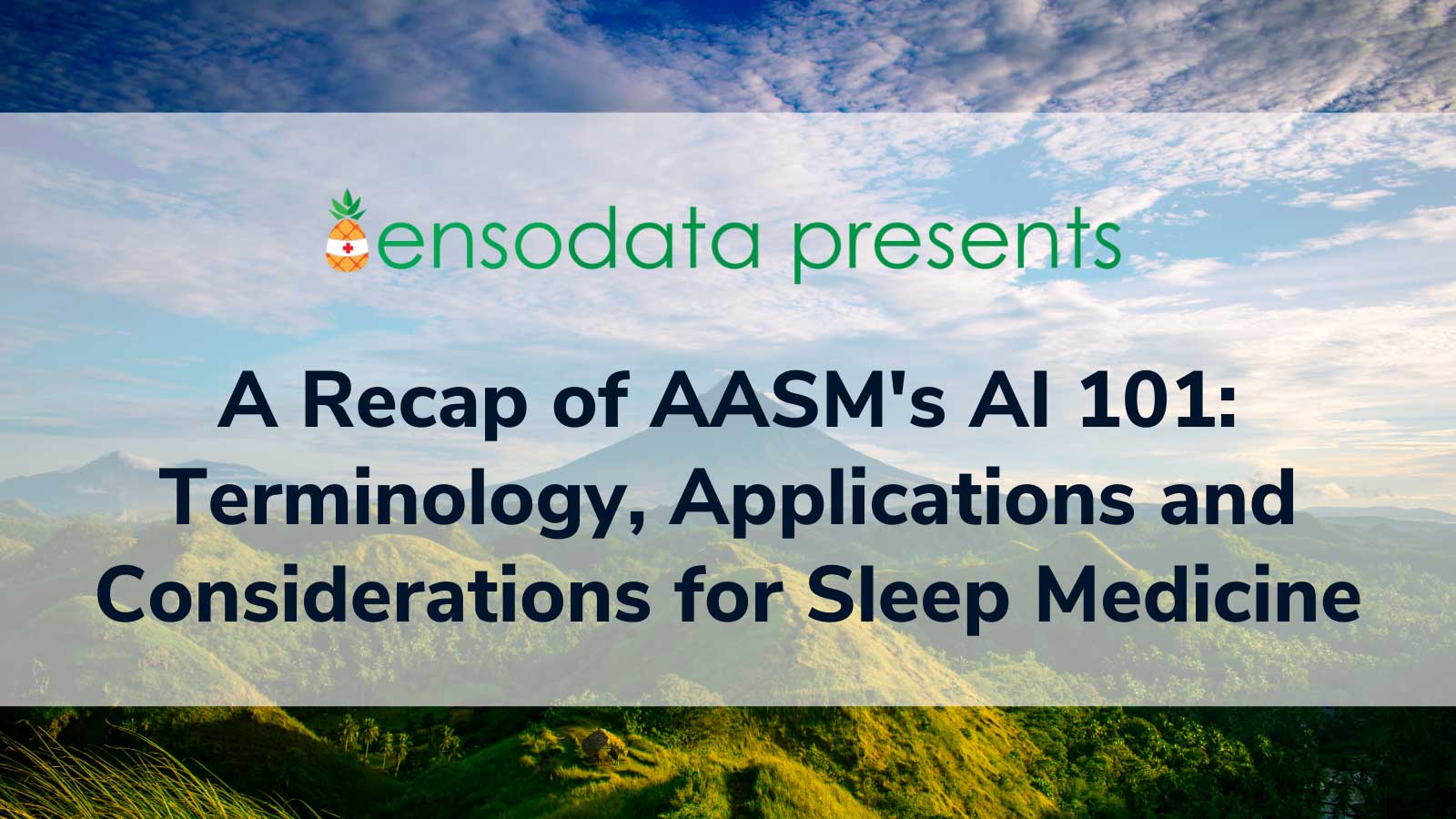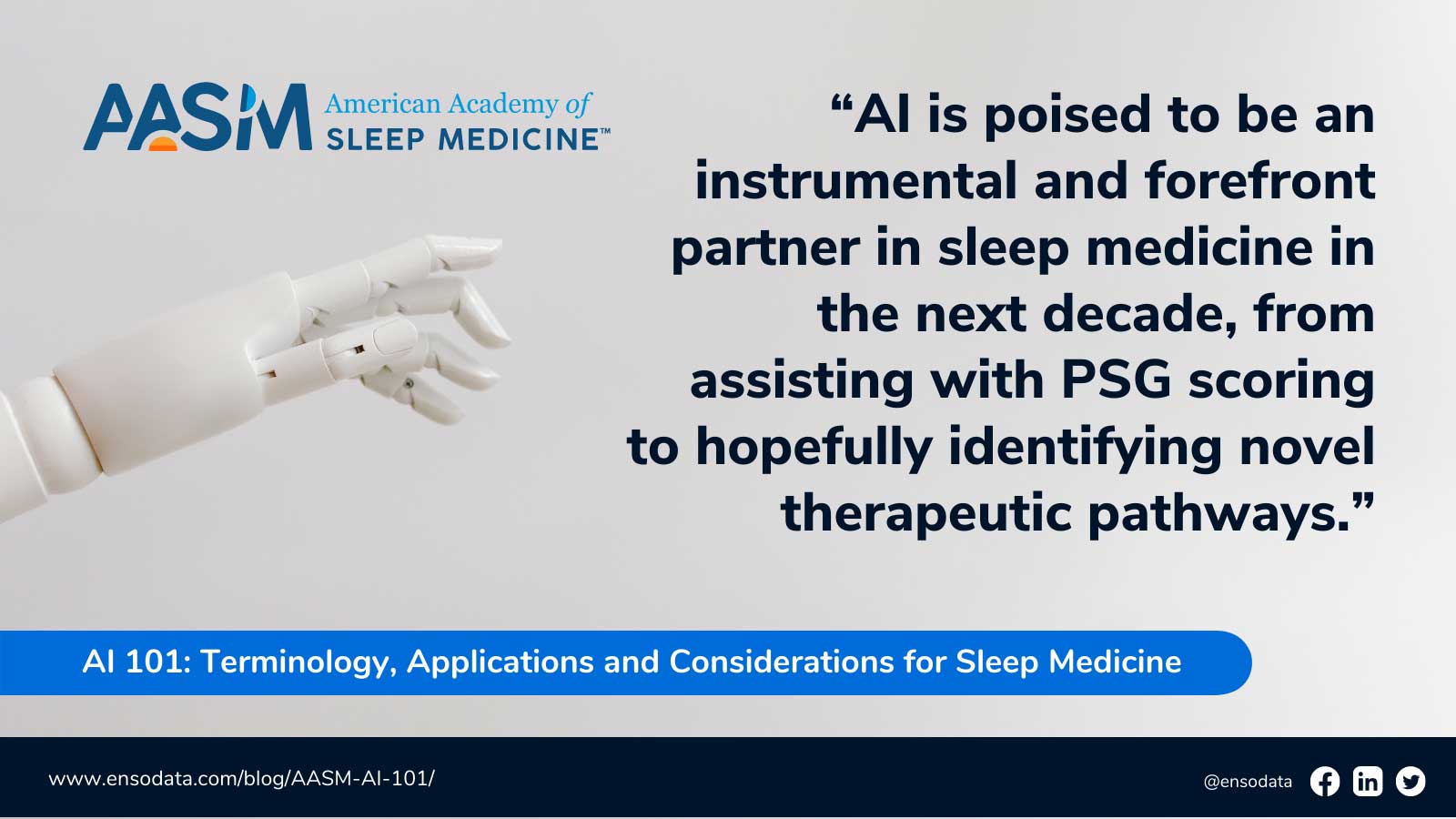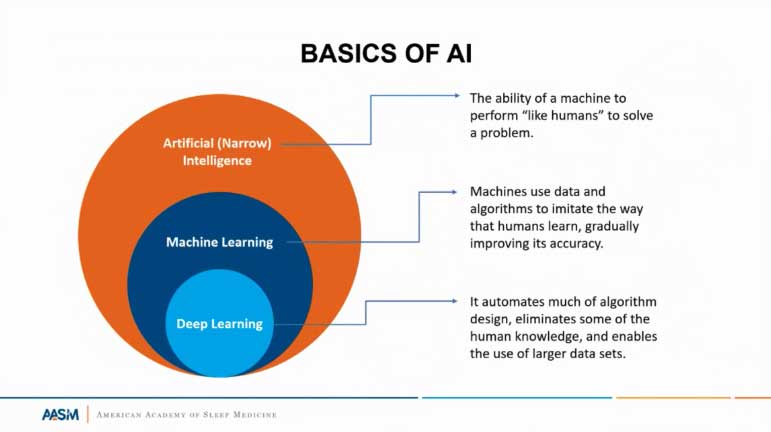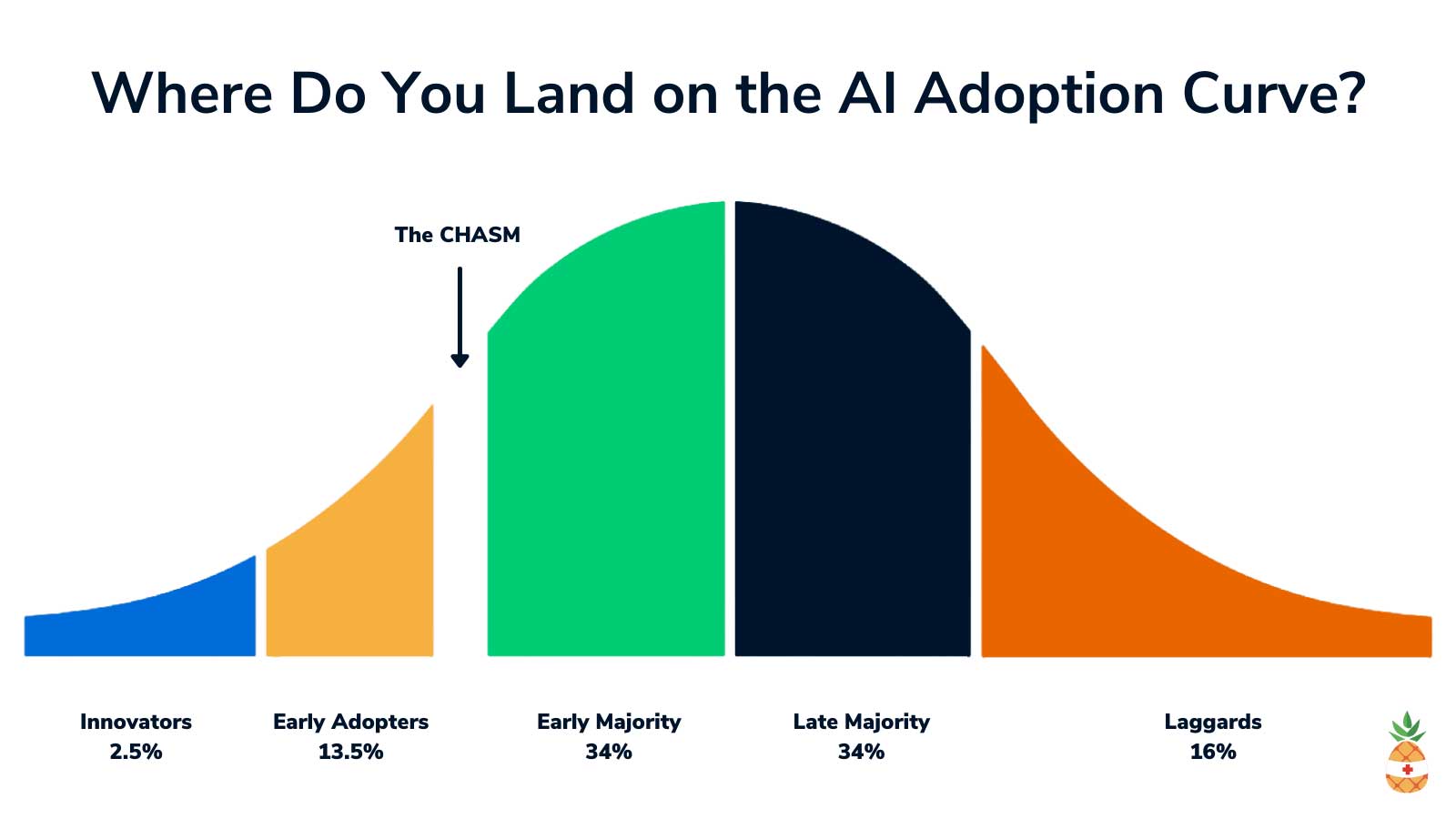
Recapping the excellent AI 101 webinar from the American Academy of Sleep Medicine (AASM)
Note: Quotes were pulled during the live AI 101 webinar and are paraphrased in this post.
AI is coming, y’all. Well, that’s according to the AASM, at least. To make sure the members of their organization are well versed in the basics of artificial intelligence (AI), the AASM hosted an outstanding AI 101 webinar on March 22, 2022. The webinar featured seven AI thought leaders in the field of sleep medicine, including our own President and co-founder, Sam Rusk. The webinar aimed to address the application of AI in sleep, while also acknowledging the validity of the concerns sleep professionals have from past experiences with auto scoring technologies. AASM’s goal for attendees in the AI 101 webinar was to become familiar with the following four areas upon completion of the program, so we’re going to dive into takeaways from each of the four, with as many quotes as possible:
AASM’s goal for attendees in the AI 101 webinar was to become familiar with the following four areas upon completion of the program, so we’re going to dive into takeaways from each of the four, with as many quotes as possible:
- Define AI, and its subsets
- Have a basic understanding how AI works (the ‘learning’ process of AI)
- Identify several ways in which AI can be helpful in the practice of sleep medicine
- Understand several concerns that exist with the application of AI in sleep medicine
What is AI?
Dr. Haoqi Sun, PhD provided the initial overview of what AI is in a succinct and easy to digest way. He explained that AI, or artificial intelligence, is broadly defined as the ability of a machine to mimic human intelligence. This intelligence can be related to specific learning, general intelligence, planning and motion, and/or reasoning. In each of these areas of intelligence, AI machines can solve various problems, each with evolving levels of intricacies. The concept of AI has been around since the 1930s, when Alan Turing conceived the universal Turing machine. Turing’s insights led to the first stored-program computer in the 40s by John von Neumann, and eventually led to modern day computers. There are two subsets of AI: machine learning (ML) and deep learning (DL). In the graphic below, you can see that ML is where machines begin to improve upon their own algorithm based on the inputted data. Go one step deeper, pun intended, and you reach the DL level, where the machine begins to leverage much larger data sets, eliminates the inputs from the human, and decides what inputs matter most through its own learning process. In short, DL allows you to automate tasks in ways you didn’t expect, which makes it a big step forward from traditional programming and early AI models.
How Does AI Actually Work?
While all AI programs share certain characteristics, the ‘how’ it works varies depending on the goal at hand. Take sleep scoring for example. When humans were the ones programming the rules for auto scoring devices in the 80s and 90s, the challenges were multiple. It was difficult to identify every single rule that had to be followed. Subjectivity between scorers also made it challenging to create a set of rules that everyone agreed upon. Algorithms of old also couldn’t improve and refine as new data and information was available. The algorithm was the algorithm, meaning problem areas remained that way. However, in recent years, machine learning and deep learning approaches have been introduced to sleep medicine. With the ability to tap into much bigger data sets, new algorithms have been developed to identify patterns that humans might not think to input. In this way, they are more finely tuned than their “if-this-then-that” programming predecessors. With this improving framework in mind, how can AI, specifically ML/DL models, support the field of sleep medicine in the future?How Can AI Help the Practice of Sleep Medicine?
Dr. Anuja Bandyopadhyay, MD, shared a number of key insights on why sleep medicine is a perfect fit for a machine learning AI solution. First, sleep medicine holds the keys to the data universe. How? Well, ‘thanks to the 8 hours of physiological data’ that’s how! The polysomnography test (PSG) records more data than humans might know how to handle, but thankfully, machine learning models can expand our own capabilities, specifically in repetitive tasks like the scoring of said PSG sleep studies. ‘In the last five years, AI scoring of PSGs has grown by leaps and bounds, and I’m really excited to see where it’s going in the future,’ noted Dr. Bandyopadhyay during the webinar. EnsoData President and co-founder Sam Rusk added:“Computer-assisted scoring is growing in adoption, which is allowing clinicians to review studies faster, spend more time with their patients, and address the larger, unreached patient populations,” said Sam Rusk.The most impactful line to us, however, came from moderator, Dr. Margarita Oks, MD, FCCP, who said: ‘We know that AI has ‘conquered’ the scoring of the PSG,’ as she transitioned into the concerns. Conquered is a strong word, so let’s address the concerns before we declare this a complete victory for AI sleep scoring.
What Concerns are Related to AI in Sleep Medicine?
Voices from the audience rained down when asked about the concerns related to AI. Is it really accurate? Can it really score challenging things like central sleep apneas? Can AI co-exist in the current framework of sleep medicine? Will it come for my job as a technologist? Concerns are always common, but Mark Spiceland, RPSGT, shared an insightful anecdote on the constant evolution of the sleep medicine landscape. ‘AI has the ability to again change the landscape of sleep medicine. The incorporation of AI in sleep isn’t a bad thing. Most technologists harbor a fear of AI, specifically of it taking their jobs,’ noted Spiceland, adding: ‘But we as sleep techs need to realize that all these tools aren’t the bogeyman; rather they are just tools in our arsenal. AI is a tool to be utilized and not feared, and we as sleep techs will need to move with that change, or risk getting washed out by it.’ Spiceland wanted other techs to trust that it works and will help serve the patient better’ Another technologist, Joseph Castillo, RST, RPSGT, CCSH, shared a similar sentiment on the webinar: He emphasized that AI isn’t the future on its own. The future of sleep medicine is technicians and technologists who embrace AI, allowing them to re-focus more on patient care. Sleep apnea is not just numbers on a page, it’s more than that.Overscoring studies is still part of the tech workload, but buying into AI allows techs to focus on other areas in the patient care continuum.‘AI isn’t a machine that will just take your job. It’s going to benefit you, your patient, but you need to be careful. AI still requires oversight,’ noted Castillo.
The Next Stage for AI in Sleep Medicine
One of the biggest challenges still facing AI Scoring is buy-in. Dr. Bandyopadhyay discussed the potential for the AASM to create its own vetting process, one to identify the credibility in each algorithm on the market. For some, it may take that much research and time, but for others, now is the time to jump aboard, as AI aims to cross the chasm into the mainstream. Ultimately, AI scoring is still in the early adopters phase in sleep medicine, but the chorus of support for embracing and seriously considering AI rained down from panelists throughout the webinar.
Like most new technology, implementing AI may seem daunting, and you need buy-in from a lot of people in the organization, but AI scoring has the potential to support your team in so many ways. To learn more about AI in Sleep Medicine, check out a few of the other resources below:
Ultimately, AI scoring is still in the early adopters phase in sleep medicine, but the chorus of support for embracing and seriously considering AI rained down from panelists throughout the webinar.
Like most new technology, implementing AI may seem daunting, and you need buy-in from a lot of people in the organization, but AI scoring has the potential to support your team in so many ways. To learn more about AI in Sleep Medicine, check out a few of the other resources below:
-
AI Scoring FAQ: https://ensodata.com/ai-scoring-faq/
-
Compare and Contrast: Artificial Intelligence Scoring and Auto Scoring in Sleep Medicine: https://ensodata.com/webinars/ensodata-webinar-ai-scoring-vs-auto-scoring/
-
Overcoming Three of Today’s Greatest Challenges in Sleep Medicine: Can AI Help?: https://ensodata.com/webinars/overcoming-three-of-todays-greatest-challenges-in-sleep/
-
Machine Learning, Deep Learning, and AI…Oh My!: https://ensodata.com/webinars/register-machine-learning-deep-learning-and-ai-oh-my/





